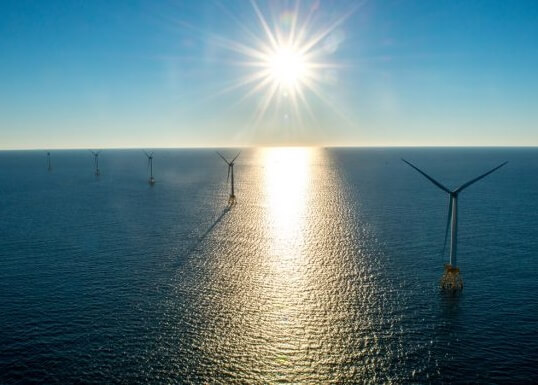Researchers at the University of Rhode Island (URI) who analyzed AirBnB rental data before and after construction of the Block Island Wind Farm have found that, contrary to some concerns, the turbines have actually increased tourism on the island.
Corey Lang, URI associate professor of environmental economics, and doctoral student Andrew Carr-Harris, say that many coastal communities that rely on tourism to sustain their economy have worried that offshore wind farms would negatively affect tourism.
“It’s a common argument for pushback against siting offshore wind, but there isn’t a lot of empirical evidence about it one way or the other,” says Lang. “There have been surveys done assessing how tourists might feel about it, based on potential images of turbines in offshore waters, but those are hypothetical.”
“Some of the recent surveys suggest that people consider offshore wind farms to be an eyesore,” adds Carr-Harris. “People tend to think the turbines will ruin the seascape and detract from their beach experience.”
The researchers collected lodging data from AirBnB to examine trends in monthly revenues, occupancy rates and reservations from roughly two years before construction of the turbines to one year after construction was completed. They compared AirBnB rental trends in Block Island to those in nearby communities that are also dependent on summer vacation rentals: Narragansett, Westerly and Nantucket.
The results were almost entirely positive for the peak summer months of July and August, and there were no noticeable effects during the rest of the year.
During July and August following construction of the turbines, AirBnB rentals in Block Island experienced, on average, a 19% increase in occupancy rates and a $3,490 increase in monthly revenue compared to those in Narragansett, Westerly and Nantucket.
“We have multiple indicators for the tourism market, and they seem to be indicative that there was an increase in interest in visiting Block Island in the year after construction of the wind farm,” says Lang.
Though the data did not indicate the reason for the increase in occupancy, Lang and Carr-Harris suggest that people were curious about the wind farm and wanted to see it for themselves.
“I think there has been some excitement about it. People are excited about renewable energy and sustainability, and they want to get behind it,” Lang explains. “So for the nation’s first offshore wind farm, we believe our results indicate that it has had a positive effect on tourism.”
“There are other factors that could be at play, too,” notes Carr-Harris. “It’s perceived that there is better fishing near the turbines, for instance, so more people may be coming to the island to go fishing.”
The researchers note that the curiosity factor may dissipate shortly, so the positive effects on vacation rentals may not persist for long.
“The long-term trajectory might be very different,” Lang says. “If it’s driven by curiosity, then we might expect it to go back to normal. But if there are fundamental things that have changed, like better fishing, then it’s likely that some enhanced opportunities that come from renewable energy may be sustained. But that’s speculation.”
Also, because the Block Island Wind Farm is the first of its kind in the U.S., it may be generating more tourism interest than will future wind farms, they point out. In addition, a small project like the Block Island Wind Farm may not generate the negative impressions that a much larger wind farm could generate in the future.
“So it’s difficult to extrapolate our results to other communities,” says Lang. “But it mitigates some fear that there’s going to be big negatives.”
Lang plans to follow up this study with an investigation of perceptions of the wind farm from the perspective of those who live on Block Island year-round.
“It’s one thing to look at a turbine for a few days and be mesmerized by it,” he adds. “But to have it there constantly may be different.”
The research was published in the journal Resource and Energy Economics. Funding was provided by Rhode Island Sea Grant.




